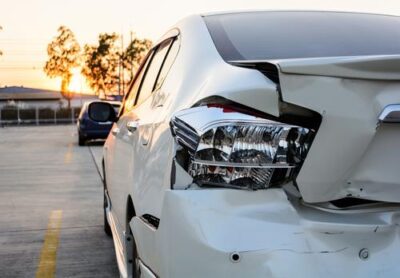
There’s a lot that goes into the value of a rear-end accident. You will need to consider both economic and non-economic damages, and calculating the total of both can be difficult. Since every case can be different, it’s best to discuss your rear-end accident with a personal injury lawyer who can help you determine how much it’s worth.
Keep reading to get a good idea of what goes into knowing how much a rear-end accident is worth—and how you can get help with your case at no-risk today. You can take charge of your legal situation with an Atlanta truck accident lawyer.
What to Know About Rear-End Accidents
A rear-end accident happens when one vehicle collides with another vehicle in front of it.
According to the National Highway and Traffic Safety Administration (NHTSA), rear-end accidents are the most common type of crash, and they lead to many injuries and deaths each year. Rear-end collisions make up about 29% of all accidents.
The damages from rear-end accidents can range anywhere from no injuries and minor bumper dents to serious, catastrophic injuries and totaled vehicles. This is why the worth of one rear-end accident can be so different from the next. How much you receive in settlement from your accident will depend on the details of your specific collision.
How Rear-End Truck Accidents Are Different
While any rear-end accident can be serious, it should be noted that rear-end truck accidents can be particularly severe.
Since semi-trucks and 18-wheelers are so huge and heavy (especially when they are fully loaded), being rear-ended by one—even at low speeds—can be deadly. The same can be said if you were the one who read-ended the truck.
If you were injured in a rear-end accident with a truck, it’s best to contact a truck accident lawyer right away. They will know how to handle the legal complexities that often come with truck accident cases. To schedule a FREE consultation with one of our experienced truck accident lawyers at John Foy & Associates, call or contact us online now.
Get the strong arm
How to Determine What a Rear-End Accident Is Worth
The compensation you receive from an auto accident that wasn’t your fault is meant to “make you whole again” as fully as possible. In other words, you may be entitled to recovery that accounts for all of the damages you have faced because of the accident.
Determining what a rear-end accident is worth will depend on your damages like medical bills, lost wages, vehicle damage, and pain and suffering. It’s also best to work with an experienced lawyer from the beginning who can help you accurately calculate all of your losses from the collision.
Let’s look a little more closely at the different areas to consider when it comes to the value of a rear-end accident.
Your Injuries and Medical Costs
Your medical costs will make up the largest portion of your rear-end accident claim, so you’ll want to get a good idea of how much treatment you will need for your injuries.
Medical damages you can include in your accident claim include:
- Doctor bills
- Hospital stays
- Ambulance fees
- Prescription medications
- Tests
- Surgeries
- Physical therapies
- Future medical costs
Rear-end accidents can leave victims with neck or back injuries, whiplash, concussions or other traumatic brain injuries (TBI), and more. It’s vital that you see a doctor as soon as possible after your rear-end accident, even if you feel okay. A lot of injuries can worsen over time, and you will want to make sure all treatment needs are documented in your claim.
If you wait too long to see a doctor, that can also reduce how much the insurance company considers your claim to be worth. They may try to say you were not hurt as badly as you say or that your doctor visit was not related to injuries resulting from the accident.
Lost Wages
If you were working before the rear-end accident, you’ll likely need to miss work because of the accident and your injuries. You can claim this missed worktime as lost wages in your claim.
If the accident leads to injuries that impact your ability to work in the future, you may also be able to claim “loss of earning capacity,” which would increase how much your claim is worth.
Vehicle Damage
Rear-end accidents almost always lead to bumper damage. However, the collision might have caused additional internal damage that is not immediately clear. In other cases, a serious rear-end collision might total a vehicle.
It’s best to get your car evaluated by a mechanic just to be sure of how much damage was done. This will give you an idea of how much vehicle damages are worth in your claim.
Pain and Suffering
Unlike the damages mentioned above, which can be demonstrated through dollar amounts, pain and suffering damages fall under non-economic damages that are more difficult to calculate. Examples of pain and suffering damages may include:
- Emotional distress
- Fear
- Anxiety
- Shock
- Humiliation or
- Loss of enjoyment of life
You will need to have a personal injury lawyer help you determine how much the pain and suffering damages from your rear-end accident are worth.
Never Accept the First Settlement Offer
How much your rear-end accident is worth also depends on how you interact with the insurance company. Most of the time, the at-fault driver’s insurance company will respond to your claim with a lowball settlement offer. From here, you will need to fight for your legal right to full compensation for the value of your claim.
To make sure you receive the full recovery you deserve, reach out to a personal injury lawyer who is experienced in working on rear-end accidents as soon as you can.
Talk to a Truck Accident Lawyer in Georgia for Free Today
At John Foy & Associates, we have been working exclusively for injury victims for over 20 years. We know what it takes to win cases—and there is no upfront fee to start working with us. Plus, we only get paid if we win you money, so working with us is risk-free.
Contact us today to discuss the details of your rear-end accident case during a FREE consultation. Contact us online to get started with your FREE consultation today.
404-400-4000 or complete a Free Case Evaluation form


